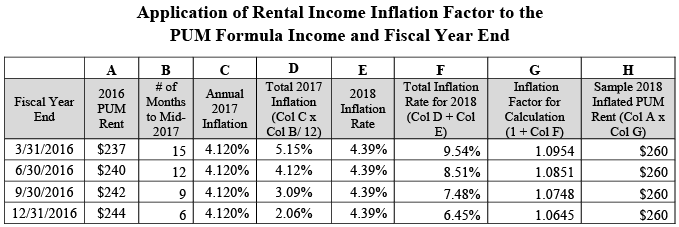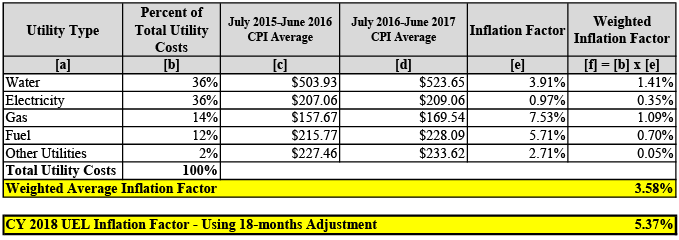2018 Operating Subsidy Formula Data
Public Housing Authorities (PHAs) are getting ready to submit their Operating Fund (Operating Subsidy) tools for 2018. Operating Fund tools will be due to the PHA’s field office by 2/2/2018. HUD issued PIH Notice 2017-27, “Public Housing Operating Subsidy Eligibility Calculations for Calendar Year (CY) 2018” which contains detailed funding methodologies for the subsidy calculation.
Some of the important items from the notice are:
- Submissions for “new” projects will be due no later than July 14, 2018.
- Submission for subsidy revisions are due August 1, 2018. The PHA should contact their field office in advance before submitting a revision.
- Formula income will be derived from the FY 2016 FDS submission. The per unit month of formula income will be inflated by the inflation factor.
- Audit costs will be pre-populated from their FY 2016 FDS submission. But, if the most recent audit cost is higher, then the PHA can edit the audit field and change the subsidy amount. Supporting documentation must be included.
- PILOT will be pre-populated from the FY 2016 FDS submission. If the PILOT is waived, then 10% of net shelter rent will be provided to those PHAs with a waived PILOT
DESIGNATION OF VACANT UNITS FOR RAD
Units in a project with a commitment to execute a HAP approval which the PHA plans to modernize and are vacant because a PHA has not reoccupied them in preparation for modernization pursuant to a RAD conversion plan can be considered as “units undergoing modernization,” provided they comply with 24 CFR 990.145. Such vacant units may be categorized as undergoing modernization for a maximum of two years (24 months) prior to RAD conversion (i.e., HAP effective date). To receive such designation, the units must be approved by the FO, and the unit status correctly reflected in PIC. Furthermore, the RAD conversion and planned modernization must be in: (i) a HUDapproved PHA Annual Plan for non-qualified PHAs (24 CFR 903); (ii) a HUD-approved 5-Year Plan for qualified PHAs (24 CFR Part 903) (if no Capital Funds are being used as part of the modernization, a narrative description of the work, including the projected start and completion date, should be included in the capital improvements section of the Plan); or (iii) a HUD-approved Capital Fund Plan (24 CFR 905.300) if Capital Funds are being used for modernization. Vacant units converting through RAD that will not be modernized are not eligible to be categorized as units undergoing modernization.
RENTAL INFLATION FARCTO
Each year HUD publishes the rental inflation factors to adjust formula income from the audited FY 2016 Fiscal Year End (FYE) financial statements approved in the Financial Assessment Subsystem (FASS). If an approved FY 2016 audited financial statement is unavailable, the approved FY 2016 unaudited financial statement provided by PHAs through HUD’s information systems will be used to determine Formula Income. Mixed finance AMPs Formula Income is typically gathered independently. The purpose of the rental inflation factor is to adjust formula income to 2018 levels based on the latest formula income in HUD’s systems (FASS). The inflation factors are derived from Total Tenant Payment (TTP) data, reported by PHAs in the HUD-50058. The inflation factors for CY 2018 are the highest in history ranging from 6.45% to 9.54% depending on the PHA’s fiscal year-end. It is essential to note that these historically high rental income inflation factors will cause subsidy to decrease dramatically this year.
.png)
UTILITY INFLATION FACTOR
The utility inflation factor for CY 2018 is 5.37%. In CY 2017 the utility inflation factor was actually a deflation factor of 7.01%. So, this somewhat modest inflation factor for 2018 is good news for this year! The utility inflation factor also includes a methodology section detailing the process that has been used to determine the rate.
The data for calculating the UEL Inflation factor for CY 2018 is extracted from the Bureau of Labor Statistics (BLS) Consumer Price Index for All Urban Consumers (CPI-U). The reporting period for the operating subsidy calculation runs from July 1 to June 30. Using the monthly indices for the 12-month period, an average index is calculated for each of the reporting periods by utility type. Nationally, the weighted change in utility price between the CY 2017 and CY 2018 reporting periods (weighted by the percentage of total public housing spending on utilities, by type) was 03.58%. The rate of change in the reporting period (03.58%) is then multiplied by 1.5 to reflect the anticipated rate that PHAs will pay during the funding period. In essence, the funding period lags the reporting period by 18 months (1.5 years). As shown below, this calculation results in a CY 2018 UEL inflation factor of 5.37%. The 03.58% (weighted rate of change in reporting period) x 1.5 (18 month lag) = 5.37% (2018 UEL Inflation Factor). The inflation factor to be used on the CY 2018 HUD Form 52722 is 1.0537, (1 + 0.0537). The inflation factor methodologies that are being used are probably not the best solutions for either utilities or rental income, but as the methodologies change so will distribution of subsidy between PHAs. If the methodologies do change, there will be some PHAs that are gainers in subsidy and some PHAs that are decliners in subsidy. Dated : 12/21/2017 Office of Public and Indian Housing Office of Public Housing Financial Management Division In order to provide PHAs with additional transparency on how inflation factors are derived, HUD has expanded the level of detail provided in its annual inflation factor guidance. This CY 2018 Formula Income Inflation Factor Guidance document will explain how the data is derived, describe the calculations that are performed, communicate the CY 2018 inflation rates, and provide additional access to data which the industry can use to more deeply analyze the resulting inflation factors. The data for calculating the UEL Inflation factor for CY 2018 is extracted from the Bureau of Labor Statistics (BLS) ‘Consumer Price Index for All Urban Consumers (CPI-U). The reporting period for the operating subsidy calculation runs from July 1 to June 30. Using the monthly indices for the 12-month period, an average index is calculated for each of the reporting periods, by utility type. Nationally, the weighted change in utility price between the CY 2017 and CY 2018 reporting periods (weighted by the percentage of total public housing spending on utilities, by type) was 03.58% (see Table 1).
The rate of change in the reporting period (03.58%) is then multiplied by 1.5 to reflect the anticipated rate that PHAs will pay during the funding period. In essence, the funding period lags the reporting period by 18 months (1.5 years). As shown below, this calculation results in a CY 2018 UEL inflation factor of 5.37%. The 03.58% (weighted rate of change in reporting period) x 1.5 (18 month lag) = 5.37% (2018 UEL Inflation Factor).
.png)
The inflation factor methodologies that are being used are probably not the best solutions for either utilities or rental income, but as the methodologies change so will distribution of subsidy between PHAs. If the methodologies do change, there will be some PHAs that are gainers in subsidy and some PHAs that are decliners in subsidy.
SHARE